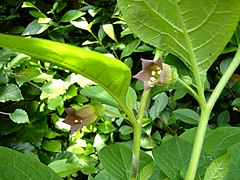Deadly nightshade
| Atropa subsp. var. | Deadly nightshade | |||||||||||||||||||||||||||||||||||||||||||||||||||||||
|---|---|---|---|---|---|---|---|---|---|---|---|---|---|---|---|---|---|---|---|---|---|---|---|---|---|---|---|---|---|---|---|---|---|---|---|---|---|---|---|---|---|---|---|---|---|---|---|---|---|---|---|---|---|---|---|---|

|
|
| ||||||||||||||||||||||||||||||||||||||||||||||||||||||
| ||||||||||||||||||||||||||||||||||||||||||||||||||||||||
Atropa belladonna, commonly known as belladonna or deadly nightshade, is a perennial herbaceous plant in the family Solanaceae, native to Europe, North Africa, and Western Asia. The foliage and berries are extremely toxic, containing tropane alkaloids.[1] These toxins include scopolamine and hyoscyamine which cause a bizarre delirium and hallucinations.[2] The drug atropine is derived from the plant.
It has a long history of use as a medicine, cosmetic, and poison. Before the Middle Ages, it was used as an anesthetic for surgery, and it was used as a poison by early men, ancient Romans, including the wives of two Emperors, and by Macbeth of Scotland before he became a Scottish King.
The genus name "atropa" comes from Atropos, one of the three Fates in Greek mythology (the one who cuts the thread of life), and the name "atropa bella donna" is derived from an admonition in Italian and Greek meaning "do not betray a beautiful lady".[3][4][5]
Atropa belladonna is a branching herbaceous perennial, often growing as a subshrub, from a fleshy rootstock. Plants grow to 1.5 m ft tall with 18 cm in long ovate leaves. The bell-shaped flowers are dull purple with green tinges and faintly scented. The fruits are berries, which are green ripening to a shiny black, and approximately 1 cm in in diameter. The berries are sweet and are consumed by animals that disperse the seeds in their droppings, even though the seeds contain toxic alkaloids.[6] There is a pale yellow flowering form called Atropa belladonna var. lutea with pale yellow fruit.
Atropa belladona is rarely used in gardens, but when grown it is usually for its large upright habit and showy berries.[7] It is naturalized in parts of North America, where it is often found in shady, moist locations with limestone-rich soils. It is considered a weed species in parts of the world,[8] where it colonizes areas with disturbed soils.[9] Germination of the small seeds is often difficult, due to hard seed coats that cause seed dormancy. Germination takes several weeks under alternating temperature conditions but can be sped up with the use of gibberellic acid.[10] The seedlings need sterile soil to prevent damping off and resent root disturbance during transplanting.
| Standard Cyclopedia of Horticulture |
|---|
|
Atropa belladonna, Linn. Plant erect, branching, leafy: Lvs. ovate, entire, pointed: fls. single or in pairs, nodding on lateral peduncles; corolla blue-purple or often greenish purple. Eu. to India.
|
Cultivation
Propagation
Pests and diseases
Varieties
Gallery
References
- ↑ Michael (1998). Alkaloids : biochemistry, ecology, and medicinal applications. New York: Plenum Press. pp. 20. ISBN 0306454653. http://books.google.com/books?id=bMCzyrAtrvYC&pg=PA20&dq=hallucinogenic++Atropa+belladonna&lr=&ei=Xe-ySYSOOY3qkQSU_Mm6Dg&client=firefox-a#PPA20,M1.
- ↑ Wilson, Jeremy Foster Heather (2008). Buzzed : the straight facts about the most used and abused drugs from alcohol to ecstasy. New York City: W.W. Norton. pp. 107. ISBN 0393329852. http://books.google.com/books?id=0SjhNDtBerYC&pg=PA107&dq=hallucinogenic++Atropa+belladonna&ei=iOqySYryBZXSlQSkxcW5Dg&client=firefox-a#PPA107,M1.
- ↑ Cite error: Invalid
<ref>tag; no text was provided for refs named.22spiegl.22 - ↑ Cite error: Invalid
<ref>tag; no text was provided for refs named.22harris.22 - ↑ Cite error: Invalid
<ref>tag; no text was provided for refs named.22groombridge.22 - ↑ Kay QON (2008). Edible fruits in a cool climate: the evolution and ecology of endozoochory in the European flora. In: Fruit and Seed Production: Aspects of Development, Environmental Physiology and Ecology (Society for Experimental Biology Seminar Series) (Ed. by C. Marshall and J. Grace). Cambridge, UK: Cambridge University Press. pp. 240. ISBN 0-521-05045-6.
- ↑ Stuart, David (2004). Dangerous garden: the quest for plants to change our lives. Cambridge: Harvard University Press. pp. 49. ISBN 0-674-01104-X.
- ↑ http://plants.usda.gov/java/profile?symbol=ATBE
- ↑ Stepp JR (June 2004). "The role of weeds as sources of pharmaceuticals". J Ethnopharmacol 92 (2-3): 163–6. doi:10.1016/j.jep.2004.03.002. PMID 15137997.
- ↑ Genova E, Komitska G, Beeva Y (1997). "Study on the germination of Atropa Bella-Donna L. Seeds" (PDF). Bulgarian Journal of Plant Physiology 23 (1-2): 61–66. http://www.bio21.bas.bg/ipp/gapbfiles/v-23/97_1-2_61-66.pdf. Retrieved 2008-07-08.
- Standard Cyclopedia of Horticulture, by L. H. Bailey, MacMillan Co., 1963
External links
- w:Deadly nightshade. Some of the material on this page may be from Wikipedia, under the Creative Commons license.
- Deadly nightshade QR Code (Size 50, 100, 200, 500)





